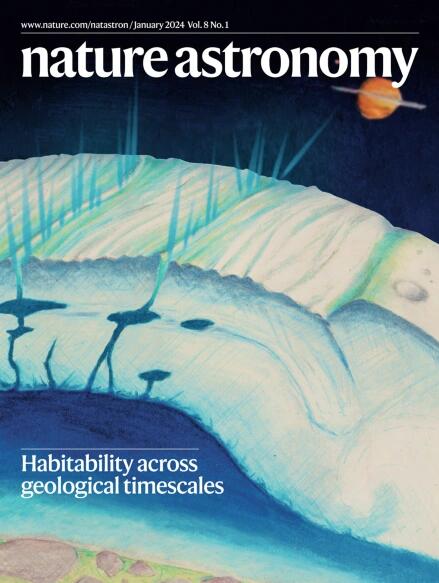一个小红点
IF 14.3
1区 物理与天体物理
Q1 ASTRONOMY & ASTROPHYSICS
引用次数: 0
摘要
小红点(lrd)因其极红和致密的辐射而得名,目前还没有一个物理解释可以与它们的全光谱能量分布(SED)一致:虽然一些光谱特征表明存在尘埃活动星系核(AGN),但其他的更自然地被解释为恒星光。观测和建模也经常受到高红移(z > 5)的阻碍,而大多数lrd都是在高红移处发现的。王炳杰和他的同事们在红移z ~ 3处提供了一个可能的LRD模拟的多波长数据,以及一个可行的结构模型。结合JWST多台仪器的观测结果、HST成像以及斯皮策和赫歇尔数据的上限,作者构建了一系列灵活处理假定的AGN和星系光的分光光度模型。虽然他们不能排除只有星系的模型,但这种模型所暗示的高恒星质量将需要一个极端的恒星表面密度,并且比物体估计的动态质量大一个数量级。另一方面,他们的联合星系- AGN模型依赖于AGN环上的尘埃异常(但并非前所未有)的低温。他们还发现了蓝移的He I吸收特征,暗示了来自超大质量黑洞(SMBH)的电离流出。本文章由计算机程序翻译,如有差异,请以英文原文为准。
A little red dot up close
求助全文
通过发布文献求助,成功后即可免费获取论文全文。
去求助
来源期刊

Nature Astronomy
Physics and Astronomy-Astronomy and Astrophysics
CiteScore
19.50
自引率
2.80%
发文量
252
期刊介绍:
Nature Astronomy, the oldest science, has played a significant role in the history of Nature. Throughout the years, pioneering discoveries such as the first quasar, exoplanet, and understanding of spiral nebulae have been reported in the journal. With the introduction of Nature Astronomy, the field now receives expanded coverage, welcoming research in astronomy, astrophysics, and planetary science. The primary objective is to encourage closer collaboration among researchers in these related areas.
Similar to other journals under the Nature brand, Nature Astronomy boasts a devoted team of professional editors, ensuring fairness and rigorous peer-review processes. The journal maintains high standards in copy-editing and production, ensuring timely publication and editorial independence.
In addition to original research, Nature Astronomy publishes a wide range of content, including Comments, Reviews, News and Views, Features, and Correspondence. This diverse collection covers various disciplines within astronomy and includes contributions from a diverse range of voices.
 求助内容:
求助内容: 应助结果提醒方式:
应助结果提醒方式:


